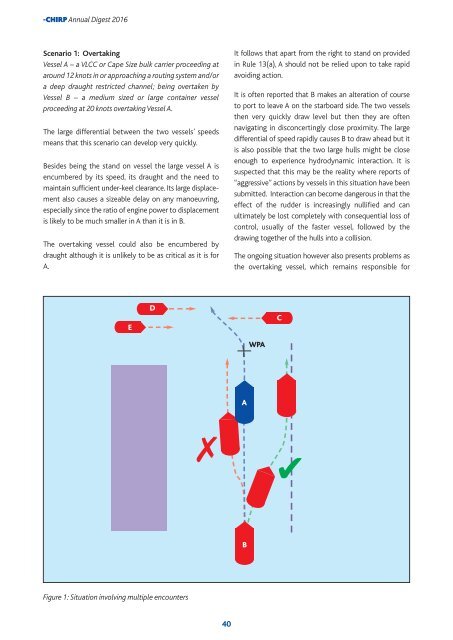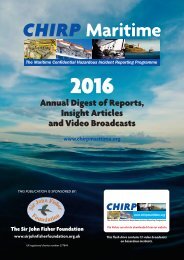CHIRP annual digest 2016 6th
You also want an ePaper? Increase the reach of your titles
YUMPU automatically turns print PDFs into web optimized ePapers that Google loves.
-<strong>CHIRP</strong> Annual Digest <strong>2016</strong><br />
Scenario 1: Overtaking<br />
Vessel A – a VLCC or Cape Size bulk carrier proceeding at<br />
around 12 knots in or approaching a routing system and/or<br />
a deep draught restricted channel; being overtaken by<br />
Vessel B – a medium sized or large container vessel<br />
proceeding at 20 knots overtaking Vessel A.<br />
The large differential between the two vessels’ speeds<br />
means that this scenario can develop very quickly.<br />
Besides being the stand on vessel the large vessel A is<br />
encumbered by its speed, its draught and the need to<br />
maintain sufficient under-keel clearance. Its large displace -<br />
ment also causes a sizeable delay on any manoeuvring,<br />
especially since the ratio of engine power to displacement<br />
is likely to be much smaller in A than it is in B.<br />
The overtaking vessel could also be encumbered by<br />
draught although it is unlikely to be as critical as it is for<br />
A.<br />
It follows that apart from the right to stand on provided<br />
in Rule 13(a), A should not be relied upon to take rapid<br />
avoiding action.<br />
It is often reported that B makes an alteration of course<br />
to port to leave A on the starboard side. The two vessels<br />
then very quickly draw level but then they are often<br />
navigating in disconcertingly close proximity. The large<br />
differential of speed rapidly causes B to draw ahead but it<br />
is also possible that the two large hulls might be close<br />
enough to experience hydrodynamic interaction. It is<br />
suspected that this may be the reality where reports of<br />
“aggressive” actions by vessels in this situation have been<br />
submitted. Interaction can become dangerous in that the<br />
effect of the rudder is increasingly nullified and can<br />
ultimately be lost completely with consequential loss of<br />
control, usually of the faster vessel, followed by the<br />
drawing together of the hulls into a collision.<br />
The ongoing situation however also presents problems as<br />
the overtaking vessel, which remains responsible for<br />
E<br />
D<br />
C<br />
WPA<br />
A<br />
✗<br />
✔<br />
B<br />
Figure 1: Situation involving multiple encounters<br />
40



